|
|
|||||||||||||||||
| Home >> Lighting | |||||||||||||||||
Lighting |
|||||||||||||||||
|
|
|||||||||||||||||
|
Lighting: Bestsellers
|
|||||||||||||||||
|
Lighting: On sale today | |||||||||||||||||
|
Shop by brand
|
|||||||||||||||||
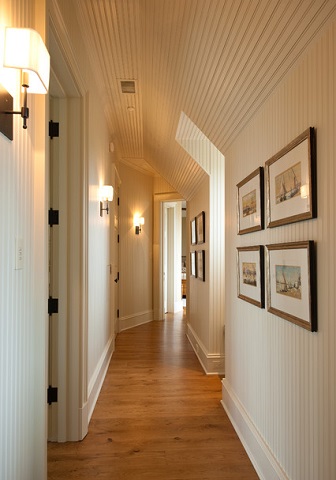 To maximize the light gained from a sconce, look for models that cast light both up and down (by Solaris Inc)[/caption]
Shop Wall Sconces:
Wall sconces are particularly prized for their visibility in a hallway. Because they install closer to eye level, they offer the greatest visual impact of any type of lighting fixture, regardless of the height of the room. That said, in a narrow hallway you want to be careful which sconce you choose; anything that sticks out too far from the wall can restrict your walkway. It's also worth noting that placing the lighting fixtures on the walls rather than the ceiling limits the amount of illumination each fixture can produce, meaning the hallway will probably end up being a bit darker than with other types of lights. To maximize the amount of light you get from a wall sconce, look for ones that cast light both upward and downward, which will emphasize the height of the wall while producing more lighting overall. As well, sconces should be alternated from one side of the hall to the other at 8-10 foot intervals, both to keep from crowding the walkway and to keep the lighting as even as possible throughout the hall.
To maximize the light gained from a sconce, look for models that cast light both up and down (by Solaris Inc)[/caption]
Shop Wall Sconces:
Wall sconces are particularly prized for their visibility in a hallway. Because they install closer to eye level, they offer the greatest visual impact of any type of lighting fixture, regardless of the height of the room. That said, in a narrow hallway you want to be careful which sconce you choose; anything that sticks out too far from the wall can restrict your walkway. It's also worth noting that placing the lighting fixtures on the walls rather than the ceiling limits the amount of illumination each fixture can produce, meaning the hallway will probably end up being a bit darker than with other types of lights. To maximize the amount of light you get from a wall sconce, look for ones that cast light both upward and downward, which will emphasize the height of the wall while producing more lighting overall. As well, sconces should be alternated from one side of the hall to the other at 8-10 foot intervals, both to keep from crowding the walkway and to keep the lighting as even as possible throughout the hall.
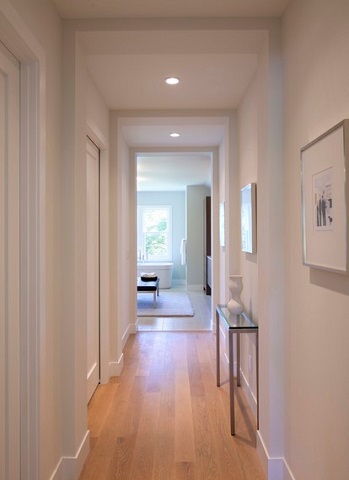 Recessed lighting produces a bright light with an unobtrusive, slightly modern appearance (by Charlie & Co. Design, Ltd)[/caption]
If sconces produce striking mood lighting, recessed lighting is all about bright functionality. Because the lights are recessed into the ceiling rather than mounted to it or hanging down from it, they cast the most over-all light for the number of bulbs used. Recessed lighting is a popular choice for a more modern decor due to the sleek, simple finish, but this same simplicity means that recessed lighting fixtures are practically invisible, meaning they'll blend well with almost any type of decor. If you want lighting that offers good coverage but won't draw attention to itself, recessed lights are really the way to go. Recessed lights are also a great option for halls with lower ceilings, not only because you won't have to worry about anyone hitting their head on your lights, but because a smooth, uninterrupted ceiling will look and feel a little bit higher than it is. Smaller recessed lights can also be combined with larger decorative lights to provide better lighting coverage without distracting from the more attractive (but maybe less bright) fixtures.
Recessed lighting produces a bright light with an unobtrusive, slightly modern appearance (by Charlie & Co. Design, Ltd)[/caption]
If sconces produce striking mood lighting, recessed lighting is all about bright functionality. Because the lights are recessed into the ceiling rather than mounted to it or hanging down from it, they cast the most over-all light for the number of bulbs used. Recessed lighting is a popular choice for a more modern decor due to the sleek, simple finish, but this same simplicity means that recessed lighting fixtures are practically invisible, meaning they'll blend well with almost any type of decor. If you want lighting that offers good coverage but won't draw attention to itself, recessed lights are really the way to go. Recessed lights are also a great option for halls with lower ceilings, not only because you won't have to worry about anyone hitting their head on your lights, but because a smooth, uninterrupted ceiling will look and feel a little bit higher than it is. Smaller recessed lights can also be combined with larger decorative lights to provide better lighting coverage without distracting from the more attractive (but maybe less bright) fixtures.
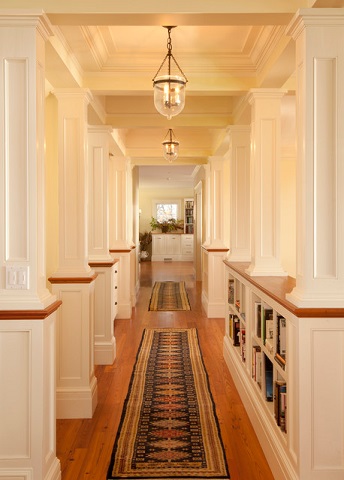 Big, decorative pendant lights can help highlight architectural ceilings in tall hallways (by Siemasko + Verbridge, photo by Blind Dog Studio)[/caption]
Shop Pendant Lighting:
Pendant lights, on the other hand, should be reserved for hallways with very high ceilings where they have plenty of room to hang down without coming anywhere near head-level. That said, if your hallway is tall enough, full sized pendant lights can be a gorgeous way to accentuate the height of the space while adding a lovely little decorative touch and, of course, plenty of light. In fact, because pendant lights often have more bulbs than smaller fixtures, they really do a great job providing thorough, overall lighting. Consider this option especially if you have decorative ceilings or doorways, as a very attractive lighting fixture will help draw the eye upward, while literally highlighting high-up details.
Big, decorative pendant lights can help highlight architectural ceilings in tall hallways (by Siemasko + Verbridge, photo by Blind Dog Studio)[/caption]
Shop Pendant Lighting:
Pendant lights, on the other hand, should be reserved for hallways with very high ceilings where they have plenty of room to hang down without coming anywhere near head-level. That said, if your hallway is tall enough, full sized pendant lights can be a gorgeous way to accentuate the height of the space while adding a lovely little decorative touch and, of course, plenty of light. In fact, because pendant lights often have more bulbs than smaller fixtures, they really do a great job providing thorough, overall lighting. Consider this option especially if you have decorative ceilings or doorways, as a very attractive lighting fixture will help draw the eye upward, while literally highlighting high-up details.
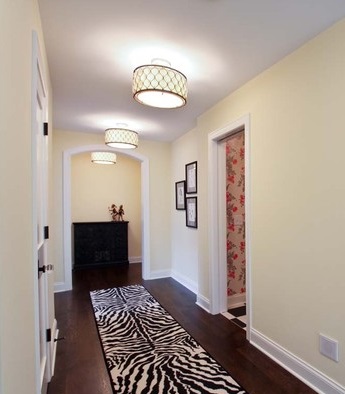 Flush mount lighting combines a compact profile with a decorative appearance that's great for dressing up a hallway with low ceilings (by REFINED LLC)[/caption]
Shop Flush Mount Lighting:
Flush mount lighting offers a nice compromise between the decorative look of a pendant and the compact functionality of recessed lighting. Like recessed lighting, flush mount lights are a better fit for hallways with lower ceilings because they sit not-quite-flat against the ceiling. Despite their compact size, though, they still come in a wide variety of styles, from simple glass domes to ornate crystal fixtures designed to mimic petite chandeliers. This is the option you want if you have low ceilings but want your hall to have a little more personality or a slightly more traditional look. Depending on the height of your ceiling, you can also find flush mount fixtures with a short, pendant-like stem which can be nice if you have a little extra head room to spare.
Flush mount lighting combines a compact profile with a decorative appearance that's great for dressing up a hallway with low ceilings (by REFINED LLC)[/caption]
Shop Flush Mount Lighting:
Flush mount lighting offers a nice compromise between the decorative look of a pendant and the compact functionality of recessed lighting. Like recessed lighting, flush mount lights are a better fit for hallways with lower ceilings because they sit not-quite-flat against the ceiling. Despite their compact size, though, they still come in a wide variety of styles, from simple glass domes to ornate crystal fixtures designed to mimic petite chandeliers. This is the option you want if you have low ceilings but want your hall to have a little more personality or a slightly more traditional look. Depending on the height of your ceiling, you can also find flush mount fixtures with a short, pendant-like stem which can be nice if you have a little extra head room to spare.
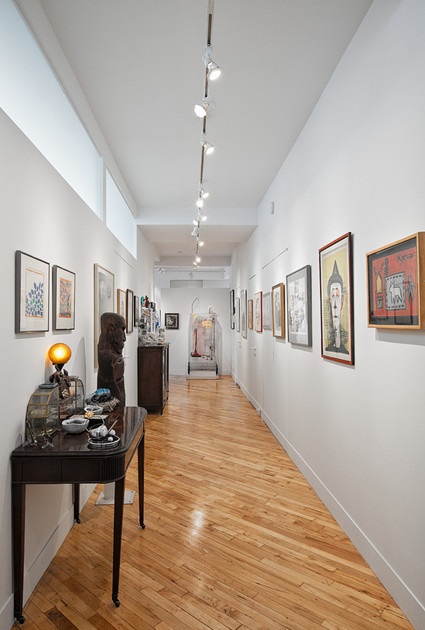 Track lighting is great for drawing attention to art and architectural details, especially in a long hallway (by Virtus Design, photo by Alex Kotlik)[/caption]
Shop Track Lighting:
Track lighting probably isn't the first thing that comes to mind when you think of using lighting to dress up a hallway, but in a very long hall it can be a surprisingly effective option. In terms of functionality, they place lights at regular intervals, giving the consistent over-all lighting that you need to keep hallways bright and safe. And because track lighting is designed to be strung together, several fixtures can easily be connected to accommodate a very long hall. But track lighting also makes for great accent lighting. Because each of the lights can be individually positioned, they can be used to highlight accents in the room, like furniture, art, or family photos hung on the walls - something that larger, more decorative lights placed at wider intervals simply cant do.
Track lighting is great for drawing attention to art and architectural details, especially in a long hallway (by Virtus Design, photo by Alex Kotlik)[/caption]
Shop Track Lighting:
Track lighting probably isn't the first thing that comes to mind when you think of using lighting to dress up a hallway, but in a very long hall it can be a surprisingly effective option. In terms of functionality, they place lights at regular intervals, giving the consistent over-all lighting that you need to keep hallways bright and safe. And because track lighting is designed to be strung together, several fixtures can easily be connected to accommodate a very long hall. But track lighting also makes for great accent lighting. Because each of the lights can be individually positioned, they can be used to highlight accents in the room, like furniture, art, or family photos hung on the walls - something that larger, more decorative lights placed at wider intervals simply cant do.
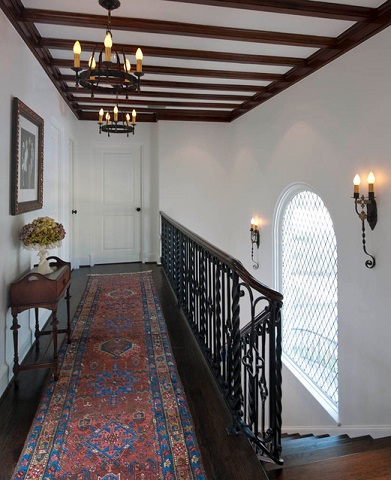 Using fixtures from a single collection in multiple rooms and halls can create an overarching visual theme and sense of coordination throughout your home (by Astelford Interiors, Inc., photo by Dan Piassick)[/caption]
Shop Chandeliers:
It's also important to remember that your hallway doesn't exist in a vacuum: it's a transitional space between one part of your home and another. What that means is that while it's easy to think of hallway lighting in purely practical terms, it's worth trying to create a sense of continuity with the rest of your home. Matching the lighting fixtures you use in your hallway to the ones used in the rooms on either side is a simple, effective way to do this. Even if they aren't the same type of lighting fixture, carrying a single design and finish color from one room to another via the hallway is a perfect, subtle way to connect the spaces and give your home a sense of visual unity.
Having adequate lighting in your hallway isn't just about looks, it's important for safety, too. Especially in a very dark hallway or one with a rug, having good, over-all lighting is a must-have for keeping your home's walkways safe, so be sure to find lighting fixtures that not only look great, but that will provide the amount of light you need to keep your space fully illuminated. Which type of hallway lighting appeals most to you? Let me know in the comments!...
Using fixtures from a single collection in multiple rooms and halls can create an overarching visual theme and sense of coordination throughout your home (by Astelford Interiors, Inc., photo by Dan Piassick)[/caption]
Shop Chandeliers:
It's also important to remember that your hallway doesn't exist in a vacuum: it's a transitional space between one part of your home and another. What that means is that while it's easy to think of hallway lighting in purely practical terms, it's worth trying to create a sense of continuity with the rest of your home. Matching the lighting fixtures you use in your hallway to the ones used in the rooms on either side is a simple, effective way to do this. Even if they aren't the same type of lighting fixture, carrying a single design and finish color from one room to another via the hallway is a perfect, subtle way to connect the spaces and give your home a sense of visual unity.
Having adequate lighting in your hallway isn't just about looks, it's important for safety, too. Especially in a very dark hallway or one with a rug, having good, over-all lighting is a must-have for keeping your home's walkways safe, so be sure to find lighting fixtures that not only look great, but that will provide the amount of light you need to keep your space fully illuminated. Which type of hallway lighting appeals most to you? Let me know in the comments!...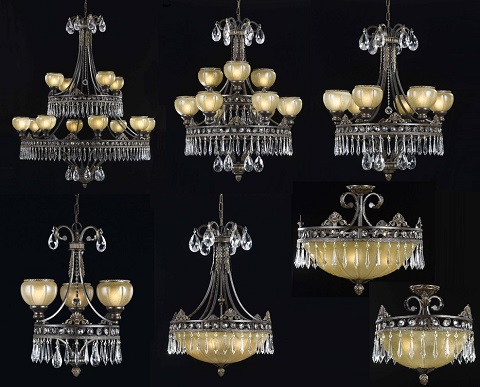 Le Grandeur Collection From Triarch International[/caption]
When you're shopping for a new lighting fixture - particularly if you're shopping online, but also if you're staring at dozens of lighting fixtures lined up on a wall - it can be hard to match the scale of the light you're looking at to the size of the room you want to put it in. All too often, you might find a light that looks just right, but isn't quite the right size. Shopping brands, like Triarch International, that offer large collections means being able to size up or down, often in very small increments, to make sure you get a light that's exactly the right size for your space and exactly the design you fell in love with, rather than a close substitution.
Le Grandeur Collection From Triarch International[/caption]
When you're shopping for a new lighting fixture - particularly if you're shopping online, but also if you're staring at dozens of lighting fixtures lined up on a wall - it can be hard to match the scale of the light you're looking at to the size of the room you want to put it in. All too often, you might find a light that looks just right, but isn't quite the right size. Shopping brands, like Triarch International, that offer large collections means being able to size up or down, often in very small increments, to make sure you get a light that's exactly the right size for your space and exactly the design you fell in love with, rather than a close substitution.
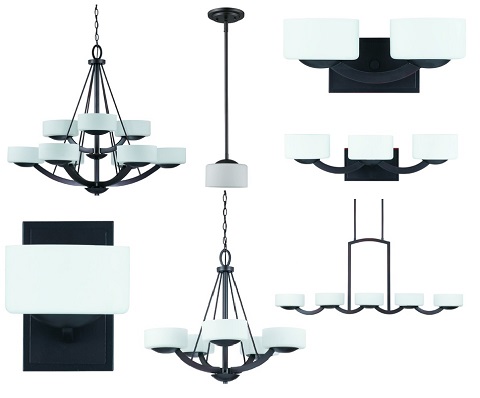 Viking Lighting Collection From Triarch International[/caption]
If you're re-imagining the lighting in a larger space, like a large living room, greatroom, or a big, open kitchen, you don't want to rely on a single fixture to get the job done. Having multiple different types of lights that fulfill different purposes - like task lighting, ambient lighting, accent lighting, and so on - is crucial to getting effective overall lighting. One light that's bright enough to illuminate the whole room will be too stark, while a few small lights might set the mood, but might not provide enough light to see by. Layering several different types of lighting fixtures allows you to make the most of the strengths of each - sconces for lighting the corners, a chandelier for show, island lighting for an island, a swing arm lamp by a reading chair, and so on. Choosing lighting fixtures that are all from the same design collection will also help keep the space looking coordinated and visually unified in a way that mis-matched lights simply won't.
Viking Lighting Collection From Triarch International[/caption]
If you're re-imagining the lighting in a larger space, like a large living room, greatroom, or a big, open kitchen, you don't want to rely on a single fixture to get the job done. Having multiple different types of lights that fulfill different purposes - like task lighting, ambient lighting, accent lighting, and so on - is crucial to getting effective overall lighting. One light that's bright enough to illuminate the whole room will be too stark, while a few small lights might set the mood, but might not provide enough light to see by. Layering several different types of lighting fixtures allows you to make the most of the strengths of each - sconces for lighting the corners, a chandelier for show, island lighting for an island, a swing arm lamp by a reading chair, and so on. Choosing lighting fixtures that are all from the same design collection will also help keep the space looking coordinated and visually unified in a way that mis-matched lights simply won't.
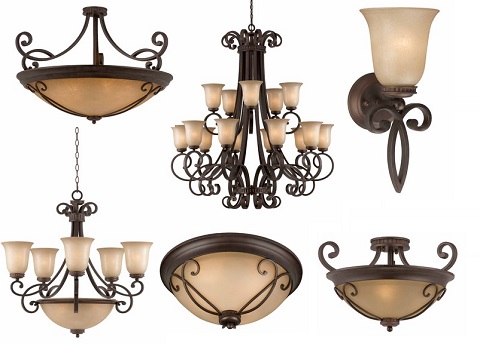 Corsica Lighting Collection From Triarch International[/caption]
Buying fixtures from a larger collection is also a good idea if you plan on redoing the lighting in more than just a single room.While having matched (or mismatched) lighting fixtures throughout your home isn't quite as obvious as it is in a single room, it is a great, subtle, almost subliminal way to unite your decor. In the same way coordinating finishes in one room helps create a visual unity, having matching lighting fixtures in every room of your home is a great way to establish a distinctive style and give your decor a nice, subtle sense of polish. The more extensive the design collection, the easier this is to do, as you'll be able to find lights in different sizes and types to fit a variety of different spaces, from a grand entrance to a small hallway, bedroom, or bathroom.
Corsica Lighting Collection From Triarch International[/caption]
Buying fixtures from a larger collection is also a good idea if you plan on redoing the lighting in more than just a single room.While having matched (or mismatched) lighting fixtures throughout your home isn't quite as obvious as it is in a single room, it is a great, subtle, almost subliminal way to unite your decor. In the same way coordinating finishes in one room helps create a visual unity, having matching lighting fixtures in every room of your home is a great way to establish a distinctive style and give your decor a nice, subtle sense of polish. The more extensive the design collection, the easier this is to do, as you'll be able to find lights in different sizes and types to fit a variety of different spaces, from a grand entrance to a small hallway, bedroom, or bathroom.
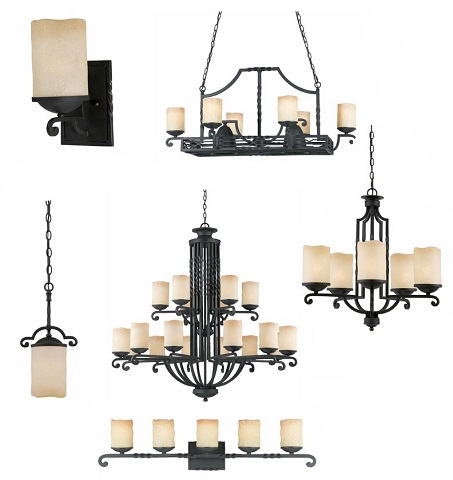 Granada Lighting Collection From Triarch International[/caption]
If you're looking for a really distinctive lighting theme - whether it's medieval style wrought iron chandeliers with candle-styled lights or just lighting fixtures with a very distinct style (like antlers, thorny vines, birds or small animals, or so on) - it's particularly worthwhile to seek out manufacturers that produce a wide variety of types of lights in the same style. If matching regular lights is difficult, coordinating a very unusual look across multiple brands is almost impossible. The drawback, of course, is that companies that offer very extensive design collections often have fewer base designs to choose from, so you might have to do a bit more hunting to get the exact style light you want.
What type of lighting fixtures are you in the market for, and what room's lighting are you planning on upgrading? Let me know in the comments!...
Granada Lighting Collection From Triarch International[/caption]
If you're looking for a really distinctive lighting theme - whether it's medieval style wrought iron chandeliers with candle-styled lights or just lighting fixtures with a very distinct style (like antlers, thorny vines, birds or small animals, or so on) - it's particularly worthwhile to seek out manufacturers that produce a wide variety of types of lights in the same style. If matching regular lights is difficult, coordinating a very unusual look across multiple brands is almost impossible. The drawback, of course, is that companies that offer very extensive design collections often have fewer base designs to choose from, so you might have to do a bit more hunting to get the exact style light you want.
What type of lighting fixtures are you in the market for, and what room's lighting are you planning on upgrading? Let me know in the comments!...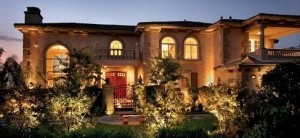 [/caption]
Uplighting is basically exactly what it sounds like: you place your lights low and point them...up. This creates a beautiful effect both against a building and in the garden. The home in the picture above uses lots and lots of uplighting; the bright light at the base of the house and garden fades vertically, creating a soft, warm, glow effect that makes it look warm and inviting. For a two story house, you want a powerful Floodlight bright enough to at least partially reach the second story, and wide enough for the light to spread out near the roof.
[caption id="attachment_1259" align="aligncenter" width="300" caption="Just A Few Up Lights Are More Striking Than Inviting, And Give Your Home A Dramatic Appearance"]
[/caption]
Uplighting is basically exactly what it sounds like: you place your lights low and point them...up. This creates a beautiful effect both against a building and in the garden. The home in the picture above uses lots and lots of uplighting; the bright light at the base of the house and garden fades vertically, creating a soft, warm, glow effect that makes it look warm and inviting. For a two story house, you want a powerful Floodlight bright enough to at least partially reach the second story, and wide enough for the light to spread out near the roof.
[caption id="attachment_1259" align="aligncenter" width="300" caption="Just A Few Up Lights Are More Striking Than Inviting, And Give Your Home A Dramatic Appearance"]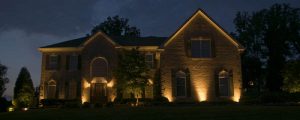 [/caption]
Smaller Spotlights also work for exterior walls, but create a much different effect, especially if you space them a little farther apart. Instead of creating a glow that envelopes your home, smaller lights create a more dramatic contrast, bringing aspects of your architecture into the fore while deepening and intensifying the shadows. This looks great both from afar and up close; curb side, the light and dark is striking, and makes your home extremely visible, and from your walkway it emphasizes the texture of your home and can partially illuminate flower beds and walkways for a warmer feel up close.
Spotlighting
[caption id="attachment_1268" align="aligncenter" width="222" caption="Single Up Lights Can Be Used To Spotlight Individual Plants Or Garden Features"]
[/caption]
Smaller Spotlights also work for exterior walls, but create a much different effect, especially if you space them a little farther apart. Instead of creating a glow that envelopes your home, smaller lights create a more dramatic contrast, bringing aspects of your architecture into the fore while deepening and intensifying the shadows. This looks great both from afar and up close; curb side, the light and dark is striking, and makes your home extremely visible, and from your walkway it emphasizes the texture of your home and can partially illuminate flower beds and walkways for a warmer feel up close.
Spotlighting
[caption id="attachment_1268" align="aligncenter" width="222" caption="Single Up Lights Can Be Used To Spotlight Individual Plants Or Garden Features"]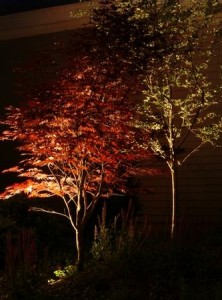 [/caption]
In daylight, you can see your whole garden, but at night you have the freedom to pick and choose how much or little you want to highlight, and spotlighting is a great way to draw attention to your favorite outdoor features. A subset of uplighting (or downlighting - though it can be harder to find a place to mount the light up high), spotlighting is, again, more or less what it sounds like: choosing a specific, usually smaller spot, and shining a light on it. This kind of lighting is great for distinctive features in your back yard. If you have trees, tall plants or flowers, or even a nice bird bath, statue, or fountain, highlighting it with a single bright light can pull an interestingly shaped or colored feature out of the darkness and make it a bold central feature of your landscape. While for a larger object like a fountain you might want a traditional angled spotlight, Well Lights work great for trees, casting a beam of light straight up into the branches and lighting the leaves from underneath - the angle makes a difference!
[caption id="attachment_1263" align="aligncenter" width="300" caption="With The Right Lighting, An Interestingly Shaped Object Also Casts A Great Shadow!"]
[/caption]
In daylight, you can see your whole garden, but at night you have the freedom to pick and choose how much or little you want to highlight, and spotlighting is a great way to draw attention to your favorite outdoor features. A subset of uplighting (or downlighting - though it can be harder to find a place to mount the light up high), spotlighting is, again, more or less what it sounds like: choosing a specific, usually smaller spot, and shining a light on it. This kind of lighting is great for distinctive features in your back yard. If you have trees, tall plants or flowers, or even a nice bird bath, statue, or fountain, highlighting it with a single bright light can pull an interestingly shaped or colored feature out of the darkness and make it a bold central feature of your landscape. While for a larger object like a fountain you might want a traditional angled spotlight, Well Lights work great for trees, casting a beam of light straight up into the branches and lighting the leaves from underneath - the angle makes a difference!
[caption id="attachment_1263" align="aligncenter" width="300" caption="With The Right Lighting, An Interestingly Shaped Object Also Casts A Great Shadow!"]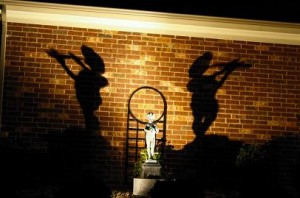 [/caption]
For example, angled spotlights can do a fantastic double duty of creating shadows. If your interesting-shaped object, be it vegetable or mineral, is located anywhere near a wall, a small, bright Accent Light or two can replicate the shape, in shadow, on the wall, like the cherub statue above. This works equally well for plants - trees look great in any season, casting shifting patterns of light and shadow when they're in full leaf, and long creepy spindly stick shadows in late fall and winter.
Grazing
[caption id="attachment_1266" align="aligncenter" width="300" caption="Grazing Lights Can Emphasize The Texture And Architecture Of Your Home"]
[/caption]
For example, angled spotlights can do a fantastic double duty of creating shadows. If your interesting-shaped object, be it vegetable or mineral, is located anywhere near a wall, a small, bright Accent Light or two can replicate the shape, in shadow, on the wall, like the cherub statue above. This works equally well for plants - trees look great in any season, casting shifting patterns of light and shadow when they're in full leaf, and long creepy spindly stick shadows in late fall and winter.
Grazing
[caption id="attachment_1266" align="aligncenter" width="300" caption="Grazing Lights Can Emphasize The Texture And Architecture Of Your Home"]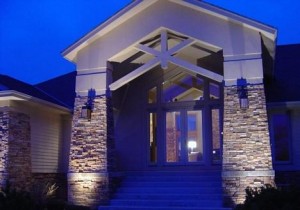 [/caption]
Grazing, another form of uplighting, is like very close-up spotlighting. Rather than highlighting the whole side of a house or an entire plant, grazing aims to feature a small patch of texture rather than the big picture. Like the entryway above - the grazing lights neither light the entry itself nor make the house itself especially pronounced. Instead, the lights primarily feature the uneven brick texture of the two columns. Small Spotlights placed at the base of the columns light the bottoms of each brick and cast small shadows where they protrude, adding depth to what might, during the daytime, be a fairly even looking surface.
[caption id="attachment_1265" align="aligncenter" width="300" caption="Grazing Lighting Can Also Highlight Interesting Natural Textures, Like Bark"]
[/caption]
Grazing, another form of uplighting, is like very close-up spotlighting. Rather than highlighting the whole side of a house or an entire plant, grazing aims to feature a small patch of texture rather than the big picture. Like the entryway above - the grazing lights neither light the entry itself nor make the house itself especially pronounced. Instead, the lights primarily feature the uneven brick texture of the two columns. Small Spotlights placed at the base of the columns light the bottoms of each brick and cast small shadows where they protrude, adding depth to what might, during the daytime, be a fairly even looking surface.
[caption id="attachment_1265" align="aligncenter" width="300" caption="Grazing Lighting Can Also Highlight Interesting Natural Textures, Like Bark"]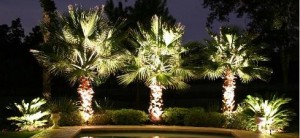 [/caption]
The same goes for plants - especially trees. Bark, like those brick columns, is naturally uneven, and when lit from below it will cast deep shadows on itself. Palm trees work especially well with this type of lighting, as their rough, tiered bark casts even more dramatic and deep shadows than your standard pine, but this technique works for basically any tree with a textured bark. For an especially dramatic look, you can actually mount a Small Accent Light directly onto the trunk of the tree, to highlight a specific portion of the bark or branches.
Silhouetting
[caption id="attachment_1260" align="aligncenter" width="189" caption="Silhoutte Lighting Can Turn Your Statuary And Topiary Into Cool Shadow Shapes"]
[/caption]
The same goes for plants - especially trees. Bark, like those brick columns, is naturally uneven, and when lit from below it will cast deep shadows on itself. Palm trees work especially well with this type of lighting, as their rough, tiered bark casts even more dramatic and deep shadows than your standard pine, but this technique works for basically any tree with a textured bark. For an especially dramatic look, you can actually mount a Small Accent Light directly onto the trunk of the tree, to highlight a specific portion of the bark or branches.
Silhouetting
[caption id="attachment_1260" align="aligncenter" width="189" caption="Silhoutte Lighting Can Turn Your Statuary And Topiary Into Cool Shadow Shapes"]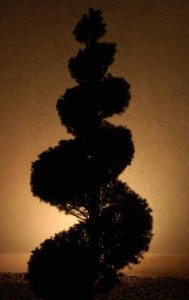 [/caption]
Silhouette lighting is something else entirely. While technically a form of uplighting, it functionally bears very little resemblance to other types of lighting in this category. Rather than highlighting a space, shape, or texture by shining light on it, silhouetting does exactly the opposite and shines a light on the wall directly behind an object like this spiral topiary. The effect is what it sounds like - the object itself is blacked out and reduced to a dark silhouette that stands out dramatically against a lit background. A Lower Voltage Light is probably preferable for this purpose, as a very bright light might spill over and light parts of what you're trying to black out, ruining the effect.
Downlighting
[caption id="attachment_1267" align="aligncenter" width="300" caption="Inside An Outbuilding Or Covered Patio, Downlighting Can Both Light The Inside Of The Structure As Well As Highlight The Architecture"]
[/caption]
Silhouette lighting is something else entirely. While technically a form of uplighting, it functionally bears very little resemblance to other types of lighting in this category. Rather than highlighting a space, shape, or texture by shining light on it, silhouetting does exactly the opposite and shines a light on the wall directly behind an object like this spiral topiary. The effect is what it sounds like - the object itself is blacked out and reduced to a dark silhouette that stands out dramatically against a lit background. A Lower Voltage Light is probably preferable for this purpose, as a very bright light might spill over and light parts of what you're trying to black out, ruining the effect.
Downlighting
[caption id="attachment_1267" align="aligncenter" width="300" caption="Inside An Outbuilding Or Covered Patio, Downlighting Can Both Light The Inside Of The Structure As Well As Highlight The Architecture"]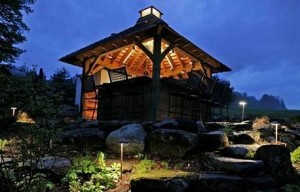 [/caption]
Downlighting is the exact opposite (as you might have guessed) of uplighting. Rather than highlighting a specific area, and letting the light dissipate upwards, downlighting uses the advantage of height to light a wide area beneath it - like ceiling lights indoors. Only outside, as with the gazebo above, you're not only lighting the area below, but you want to make sure the light shows outside as well, to highlight the building and make it look warm and inviting from afar. That means that, in addition to your typical Overhead Lighting, you're probably going to want some top or wall-mounting Floodlights as well. As you can see in the image above, though, outside the gazebo there's a different type of downlighting as well: several Tall Downward Facing Path Lights scattered around the landscape and walkways. These cast light downward on the ground to gently highlight the surrounding area.
[caption id="attachment_1264" align="aligncenter" width="300" caption="Downlighting Near The Ground Can Illuminate A Walkway"]
[/caption]
Downlighting is the exact opposite (as you might have guessed) of uplighting. Rather than highlighting a specific area, and letting the light dissipate upwards, downlighting uses the advantage of height to light a wide area beneath it - like ceiling lights indoors. Only outside, as with the gazebo above, you're not only lighting the area below, but you want to make sure the light shows outside as well, to highlight the building and make it look warm and inviting from afar. That means that, in addition to your typical Overhead Lighting, you're probably going to want some top or wall-mounting Floodlights as well. As you can see in the image above, though, outside the gazebo there's a different type of downlighting as well: several Tall Downward Facing Path Lights scattered around the landscape and walkways. These cast light downward on the ground to gently highlight the surrounding area.
[caption id="attachment_1264" align="aligncenter" width="300" caption="Downlighting Near The Ground Can Illuminate A Walkway"]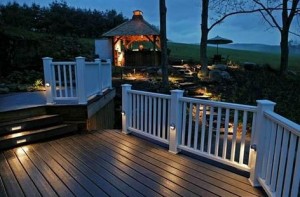 [/caption]
On a smaller scale, downlighting falls into several other categories including Step Lights, Path Lights, and even some sconce-style Deck Lights. Basically, downlighting in this sense uses a smaller height to cast a pool of light on a smaller area, whether it be a part of the landscape or a walkway or other well-trafficked area. More than any other form of lighting, low-lying downlighting is super important for safety if you or your guests spend any amount of time walking around in your back yard at night. While uplighting and its various forms are primarily about making your back yard look good, downlighting, in all its forms, is more about making that same space more livable - both well lit for spending time in as well as making it safe to walk in.
Whatever kind of lighting you end up choosing, perhaps one of the most important things to remember is that, unless the light fixture itself is prominently displayed, you shouldn't worry too much about what it looks like. Instead, focus on the shape and power of the light, to make sure that it will highlight exactly what you want it to in the way you want it to. There's a world of difference between a huge floodlight and a spotlight, or even different shaped or height path lights, so once you have an idea of what techniques you want to use where, make sure you pick the right light for the job. Are you looking to do a big landscape lighting job, or a smaller one? What's your favorite lighting technique? Has reading this post made you think of something in your own garden you'd like to see lit up? Let me know in the comments!...
[/caption]
On a smaller scale, downlighting falls into several other categories including Step Lights, Path Lights, and even some sconce-style Deck Lights. Basically, downlighting in this sense uses a smaller height to cast a pool of light on a smaller area, whether it be a part of the landscape or a walkway or other well-trafficked area. More than any other form of lighting, low-lying downlighting is super important for safety if you or your guests spend any amount of time walking around in your back yard at night. While uplighting and its various forms are primarily about making your back yard look good, downlighting, in all its forms, is more about making that same space more livable - both well lit for spending time in as well as making it safe to walk in.
Whatever kind of lighting you end up choosing, perhaps one of the most important things to remember is that, unless the light fixture itself is prominently displayed, you shouldn't worry too much about what it looks like. Instead, focus on the shape and power of the light, to make sure that it will highlight exactly what you want it to in the way you want it to. There's a world of difference between a huge floodlight and a spotlight, or even different shaped or height path lights, so once you have an idea of what techniques you want to use where, make sure you pick the right light for the job. Are you looking to do a big landscape lighting job, or a smaller one? What's your favorite lighting technique? Has reading this post made you think of something in your own garden you'd like to see lit up? Let me know in the comments!...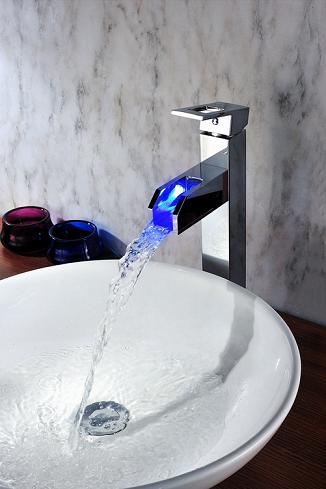 S1316CM Thermal Waterfall LED Bathroom Faucet From Sumerain[/caption]
Personally, I think waterfall faucets of every stripe are pretty. There’s just something about the ever so slightly more natural fall of the water that I just find incredibly enticing. It’s unexpected and a little earthy, neither of which are features you usually find in the bathroom. Adding even a single, simple light to the mix makes for an even more stunning appearance. Here, in full light the LED isn’t quite bright enough to make the whole stream of water glow (though it would in the dark), but it gives the hollow, open, sheath-style faucet a crisp cool glow that’s soothing and decorative without being kitschy.
S1316CM Thermal Waterfall LED Bathroom Faucet From Sumerain[/caption]
Personally, I think waterfall faucets of every stripe are pretty. There’s just something about the ever so slightly more natural fall of the water that I just find incredibly enticing. It’s unexpected and a little earthy, neither of which are features you usually find in the bathroom. Adding even a single, simple light to the mix makes for an even more stunning appearance. Here, in full light the LED isn’t quite bright enough to make the whole stream of water glow (though it would in the dark), but it gives the hollow, open, sheath-style faucet a crisp cool glow that’s soothing and decorative without being kitschy.
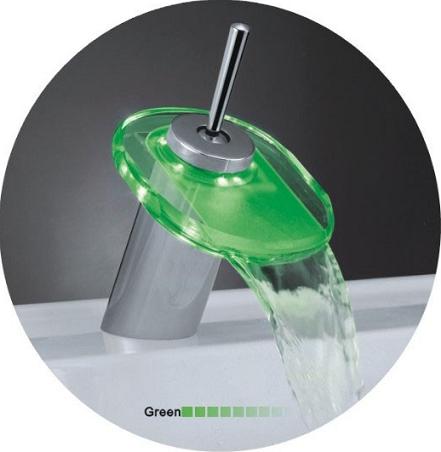 Sumerain S1007CM Single Hole Faucet Sink Bathroom Polished Chrome[/caption]
Of any of the faucets on this list, these are probably the most novel. The joystick-style handle, spigot, and LED lights are encased inside two heavy duty pieces of plastic that light up when the water turns on. The lights get brighter the more intense the flow of water, and change color depending on the temperature. The flat, waterfall style sheet of water the faucet produces is tinted with the color of the lights, too. A little more on the gimmicky side, sure but personally I actually really like the slightly futuristic look and feel of this basic LED faucet. Even when it’s turned off, the clear plastic oval is nice and elegant, and the joystick handle accentuates the cutting edge modernity of the faucet as a whole.
Sumerain S1007CM Single Hole Faucet Sink Bathroom Polished Chrome[/caption]
Of any of the faucets on this list, these are probably the most novel. The joystick-style handle, spigot, and LED lights are encased inside two heavy duty pieces of plastic that light up when the water turns on. The lights get brighter the more intense the flow of water, and change color depending on the temperature. The flat, waterfall style sheet of water the faucet produces is tinted with the color of the lights, too. A little more on the gimmicky side, sure but personally I actually really like the slightly futuristic look and feel of this basic LED faucet. Even when it’s turned off, the clear plastic oval is nice and elegant, and the joystick handle accentuates the cutting edge modernity of the faucet as a whole.
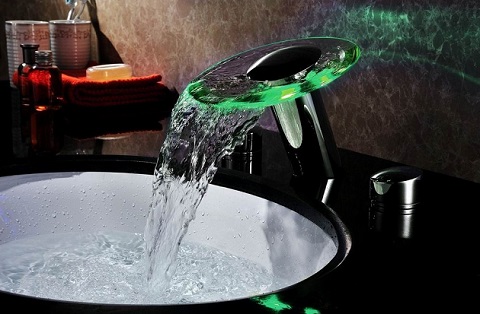 Sumerain S1356CM Widespread LED Bathroom Sink Faucet With Glass Spout In Polished Chrome[/caption]
Some of my favorite waterfall faucets are the kind that often come paired with matching vessel sink. These are generally a single piece of curved, dish-shaped glass or plastic attached to a post, either with a joystick style handle in the center or a separate control. Typically, this glass “bowl” is made of the same material and in the same color or pattern as the corresponding vessel sinks, and is designed so that water wells up from the center and tumbles naturally over the lowered edge into the sink. Adding a simple LED light to a clear glass or plastic piece allows it to have its own personality outside a coordinating sink, with a soft, lovely glow that’s pleasantly eye catching without being overly conspicuous.
Sumerain S1356CM Widespread LED Bathroom Sink Faucet With Glass Spout In Polished Chrome[/caption]
Some of my favorite waterfall faucets are the kind that often come paired with matching vessel sink. These are generally a single piece of curved, dish-shaped glass or plastic attached to a post, either with a joystick style handle in the center or a separate control. Typically, this glass “bowl” is made of the same material and in the same color or pattern as the corresponding vessel sinks, and is designed so that water wells up from the center and tumbles naturally over the lowered edge into the sink. Adding a simple LED light to a clear glass or plastic piece allows it to have its own personality outside a coordinating sink, with a soft, lovely glow that’s pleasantly eye catching without being overly conspicuous.
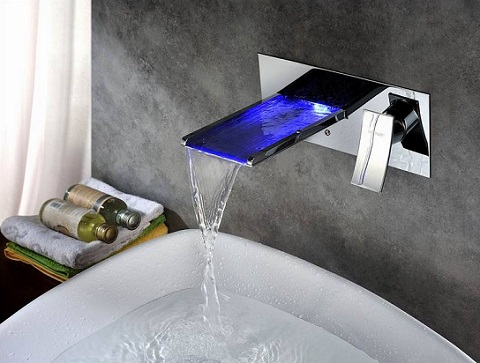 Sumerain S1289CM Waterfall Bathroom Sink Faucet[/caption]
One of the big popular trends right now is to mount your bathroom faucet on the wall instead of directly into your sink or vanity top. Now, this is a project that isn’t necessarily easily done, and it tends to pair a little better with a vessel sink, which can accentuate the natural fall of the water while helping to prevent splashing. But again, ones with built in LED lights add just that little extra something. For example, this faucet consists almost entirely of a flat piece of metal with a shallow rim around the edges, attached to a wall plate with a (rather neat looking) handle. By itself, this faucet might look a little square or blocky. But the soft LED light creates a sort of lagoon-like appearance within the open spigot, emanating a soft, enticing glow that dissipates once the water cascades over the edge and down into the sink.
Sumerain S1289CM Waterfall Bathroom Sink Faucet[/caption]
One of the big popular trends right now is to mount your bathroom faucet on the wall instead of directly into your sink or vanity top. Now, this is a project that isn’t necessarily easily done, and it tends to pair a little better with a vessel sink, which can accentuate the natural fall of the water while helping to prevent splashing. But again, ones with built in LED lights add just that little extra something. For example, this faucet consists almost entirely of a flat piece of metal with a shallow rim around the edges, attached to a wall plate with a (rather neat looking) handle. By itself, this faucet might look a little square or blocky. But the soft LED light creates a sort of lagoon-like appearance within the open spigot, emanating a soft, enticing glow that dissipates once the water cascades over the edge and down into the sink.
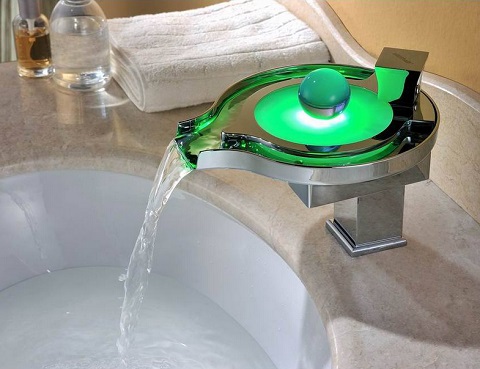 S1305CM Thermal LED Waterfall Faucet From Sumerain[/caption]
Then, there are bathroom faucets so awesome and bizarre that that they almost couldn’t exist without crazy, built in LED lights. This faucet is one of my very favorites in this delightfully weird, futuristic subcategory. At its heart, it’s a waterfall faucet, but instead of merely guiding water to cascade into the sink, the water flows around inside the labyrinthine body of the faucet, which is topped by an orb that glows when the water is flowing, giving the whole piece a fantastic, futuristic fountain look that I haven’t seen captured nearly so well elsewhere. This piece is definitely an eye-catcher, but again instead of seeming gimmicky, the LED lights are an organic part of the design, giving it a great, ultramodern vibe.
But what do you think? Do you like the futuristic look of these LED faucets? Let me know in the comments below!...
S1305CM Thermal LED Waterfall Faucet From Sumerain[/caption]
Then, there are bathroom faucets so awesome and bizarre that that they almost couldn’t exist without crazy, built in LED lights. This faucet is one of my very favorites in this delightfully weird, futuristic subcategory. At its heart, it’s a waterfall faucet, but instead of merely guiding water to cascade into the sink, the water flows around inside the labyrinthine body of the faucet, which is topped by an orb that glows when the water is flowing, giving the whole piece a fantastic, futuristic fountain look that I haven’t seen captured nearly so well elsewhere. This piece is definitely an eye-catcher, but again instead of seeming gimmicky, the LED lights are an organic part of the design, giving it a great, ultramodern vibe.
But what do you think? Do you like the futuristic look of these LED faucets? Let me know in the comments below!... Celeron Ceiling Lamp Pure 50099 in Clear from Zuo Modern[/caption]
Many modern hanging lights and ceiling fixtures actually have a similar design – many small pendants or even just decorative bulbs attached to a long, covered cord. Some are designed to come together in a sort of bouquet, while others have flexible cloth cords that can be draped or arranged as you please, making them delightfully customizable in terms of height, length, and positioning. And then there are those like this lovely Celeron Fixture which are a fixed height and length, all attached to a single base, but hanging individually. I actually really love the simple femininity of this design, with the simple glass sheaths suspended from 55 inch long wires – very minimal, but with a nice sense of balance and weightlessness.
Celeron Ceiling Lamp Pure 50099 in Clear from Zuo Modern[/caption]
Many modern hanging lights and ceiling fixtures actually have a similar design – many small pendants or even just decorative bulbs attached to a long, covered cord. Some are designed to come together in a sort of bouquet, while others have flexible cloth cords that can be draped or arranged as you please, making them delightfully customizable in terms of height, length, and positioning. And then there are those like this lovely Celeron Fixture which are a fixed height and length, all attached to a single base, but hanging individually. I actually really love the simple femininity of this design, with the simple glass sheaths suspended from 55 inch long wires – very minimal, but with a nice sense of balance and weightlessness.
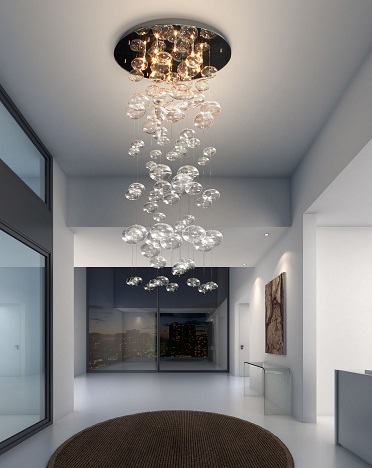 Inertia Ceiling Lamp 50115 in Clear from Zuo Modern[/caption]
While I’m a fan of traditional chandeliers, they certainly aren’t for every space. And while it’s possible to make them work in a modern decor, you need a strong eye for design and iron nerves to pull it off well. But that doesn’t mean you can’t get shades of that luxurious style in a smaller or more modern home. In fact, I might like modern hanging fixtures that riff on classic chandeliers even more than I like the chandeliers themselves. Take this Inertia Ceiling Lamp – it has one of my favorite chandelier features in the draping, light catching clear baubles, but these small glass balls are disembodied, connected by threads so thin you can hardly see them. Without the actual chandelier part, you get something much, much more modern, but without losing the shimmering gossamer beauty of the dangling crystals.
Inertia Ceiling Lamp 50115 in Clear from Zuo Modern[/caption]
While I’m a fan of traditional chandeliers, they certainly aren’t for every space. And while it’s possible to make them work in a modern decor, you need a strong eye for design and iron nerves to pull it off well. But that doesn’t mean you can’t get shades of that luxurious style in a smaller or more modern home. In fact, I might like modern hanging fixtures that riff on classic chandeliers even more than I like the chandeliers themselves. Take this Inertia Ceiling Lamp – it has one of my favorite chandelier features in the draping, light catching clear baubles, but these small glass balls are disembodied, connected by threads so thin you can hardly see them. Without the actual chandelier part, you get something much, much more modern, but without losing the shimmering gossamer beauty of the dangling crystals.
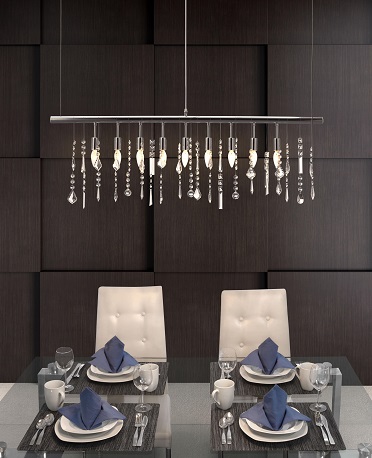 Shooting Stars Ceiling Lamp 50029 in Chrome from Zuo Modern[/caption]
In that same vein is this lovely Shooting Stars Light, which actually uses the same type and shape crystals you’d expect to find on a more conventional chandelier. The twist here is that instead of an elaborate cast brass base, this “chandelier” is hung from a single simple chrome bar. The look is both utterly modern and tastefully classic, one part mobile and one part chic dining room lighting. I like it especially for the way it catches the light, with traditional flame-shaped bulbs that point down instead of up and blend in with the suspended strands of crystals, showing them off to the best effect.
Shooting Stars Ceiling Lamp 50029 in Chrome from Zuo Modern[/caption]
In that same vein is this lovely Shooting Stars Light, which actually uses the same type and shape crystals you’d expect to find on a more conventional chandelier. The twist here is that instead of an elaborate cast brass base, this “chandelier” is hung from a single simple chrome bar. The look is both utterly modern and tastefully classic, one part mobile and one part chic dining room lighting. I like it especially for the way it catches the light, with traditional flame-shaped bulbs that point down instead of up and blend in with the suspended strands of crystals, showing them off to the best effect.
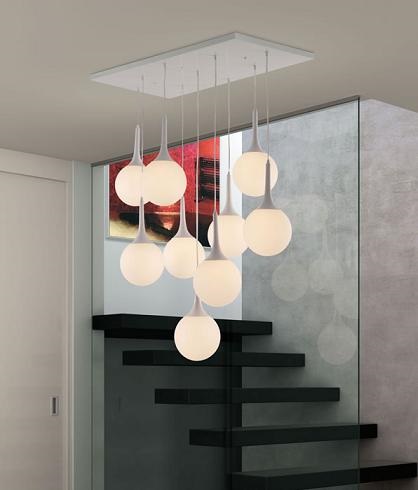 Epsilon Ceiling Lamp 50088 in White from Zuo Modern[/caption]
What I like most about this style of light, though, is not so much the sense of weightlessness inherent in the suspension of the various parts, or even the wink-and-nod reference to older forms. It’s the sense of motion created by several different lights suspended near one another, especially at different heights. This Epsilon Light accomplishes this especially well, with a scattering of luminous globe lights that give the impression both of something dripping or raining downward and, simultaneously, of something floating upwards – reminiscent of rising paper lanterns. This design doesn’t owe homage to any particular traditional design, and that’s part of why I think it’s so brilliant – it’s both unexpected and unique, a great way to add the flair of modern lighting to your space, a minimalist sense of elegance, and (with 9 25 watt bulbs) a whole lot of light.
Epsilon Ceiling Lamp 50088 in White from Zuo Modern[/caption]
What I like most about this style of light, though, is not so much the sense of weightlessness inherent in the suspension of the various parts, or even the wink-and-nod reference to older forms. It’s the sense of motion created by several different lights suspended near one another, especially at different heights. This Epsilon Light accomplishes this especially well, with a scattering of luminous globe lights that give the impression both of something dripping or raining downward and, simultaneously, of something floating upwards – reminiscent of rising paper lanterns. This design doesn’t owe homage to any particular traditional design, and that’s part of why I think it’s so brilliant – it’s both unexpected and unique, a great way to add the flair of modern lighting to your space, a minimalist sense of elegance, and (with 9 25 watt bulbs) a whole lot of light.
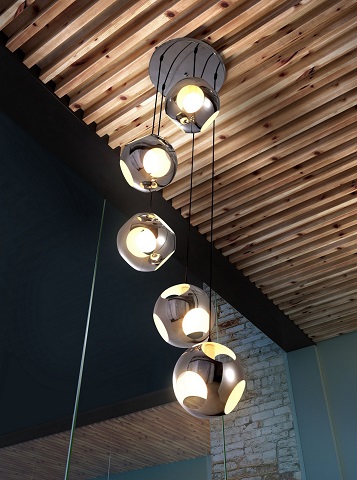 Meteor Shower Ceiling Lamp 50102 in Chrome from Zuo Modern[/caption]
Finally, chandeliers aren’t the only type of lighting that modern designers have gotten their hands on. I particularly like this Meteor Shower Hanging Light, which plays on the conventional idea of track lighting. It has the same metal globe casings (though with more holes to let out light), but rather than sitting on a long horizontal metal track, it (like many of the other hanging lights I’ve mentioned here) is suspended on a series of thin wires. Once again, this has a cool sense of motion to it, with each light hanging at a different height and slightly different placement to create a subtle snaking curve. The finish is a highly modern chrome, and again the fixture exhibits a delicate minimalism – perfect for a modern space.
Modern design has a bad reputation for being stark and minimalist, but stripping down, reassembling, and re-imagining traditional lighting fixtures is a great way to add a touch of elegance and glamour to a contemporary space....
Meteor Shower Ceiling Lamp 50102 in Chrome from Zuo Modern[/caption]
Finally, chandeliers aren’t the only type of lighting that modern designers have gotten their hands on. I particularly like this Meteor Shower Hanging Light, which plays on the conventional idea of track lighting. It has the same metal globe casings (though with more holes to let out light), but rather than sitting on a long horizontal metal track, it (like many of the other hanging lights I’ve mentioned here) is suspended on a series of thin wires. Once again, this has a cool sense of motion to it, with each light hanging at a different height and slightly different placement to create a subtle snaking curve. The finish is a highly modern chrome, and again the fixture exhibits a delicate minimalism – perfect for a modern space.
Modern design has a bad reputation for being stark and minimalist, but stripping down, reassembling, and re-imagining traditional lighting fixtures is a great way to add a touch of elegance and glamour to a contemporary space....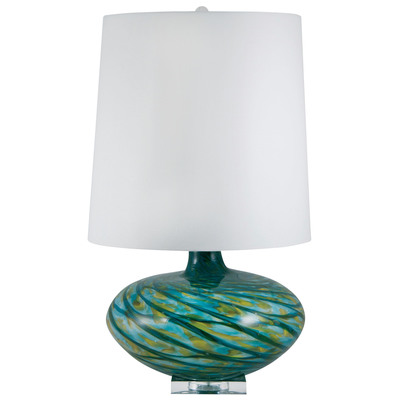 Big Bang Blown Glass Table Lamp in Blue Swirl, 312 by Lamp Works[/caption]
Like I mentioned above, lamps come in all shapes and sizes, and Lamp Works has a great variety. A lamp can be a piece of art, like the one pictured above, or it can be demure and and not draw attention to itself. It all depends on what you're going for--statement piece, or just illumination. An element of your decor, or just something that doesn't detract from it. Most of Lamp Works pieces come with a choice of bulb type--regular incandescent lights, or LED light. The LED style is a little more expensive, but LED lights are significantly more cost-effective. They last longer, don't give off as much heat, and can be brightened and dimmed more easily. If being green is one of your goals, an LED lamp might be the way to go.
Background Fade
[caption id="attachment_13811" align="aligncenter" width="345"]
Big Bang Blown Glass Table Lamp in Blue Swirl, 312 by Lamp Works[/caption]
Like I mentioned above, lamps come in all shapes and sizes, and Lamp Works has a great variety. A lamp can be a piece of art, like the one pictured above, or it can be demure and and not draw attention to itself. It all depends on what you're going for--statement piece, or just illumination. An element of your decor, or just something that doesn't detract from it. Most of Lamp Works pieces come with a choice of bulb type--regular incandescent lights, or LED light. The LED style is a little more expensive, but LED lights are significantly more cost-effective. They last longer, don't give off as much heat, and can be brightened and dimmed more easily. If being green is one of your goals, an LED lamp might be the way to go.
Background Fade
[caption id="attachment_13811" align="aligncenter" width="345"]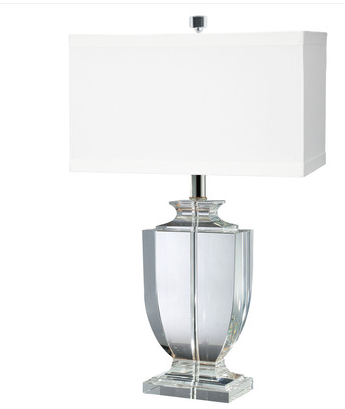 Crystal Rectangular Urn Table Lamp, 722, by Lamp Works[/caption]
Here's a lamp that could potentially fade into the background (literally, being see-through) if you weren't looking for it to have direct involvement in your decor. It's got a traditional shape, no bright colors or shouty patterns, and would match just about any surface. It would also fit quite well into a contemporary theme, or an art-deco one.
Two of a Kind
[caption id="attachment_13813" align="aligncenter" width="401"]
Crystal Rectangular Urn Table Lamp, 722, by Lamp Works[/caption]
Here's a lamp that could potentially fade into the background (literally, being see-through) if you weren't looking for it to have direct involvement in your decor. It's got a traditional shape, no bright colors or shouty patterns, and would match just about any surface. It would also fit quite well into a contemporary theme, or an art-deco one.
Two of a Kind
[caption id="attachment_13813" align="aligncenter" width="401"]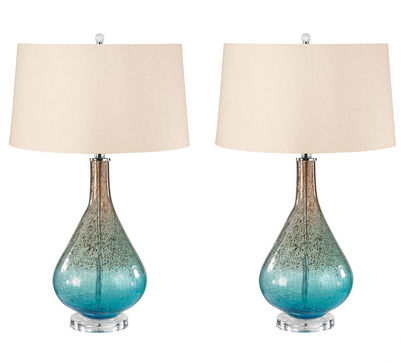 Earth and Sky Crackle Glass Table Lamp, 288/S2 by Lamp Works[/caption]
When you start looking for a lamp, the first thing you want to ask yourself is what kind of space you are going to be working with. If you don't have a lot of surface area, you don't want a huge, cumbersome piece. Some lamps get warm, too, so factor that in too--try to avoid curtains or other fabrics. If your space is limited, consider several small lamps instead of one large one. Depending on your decor, you could go for a matching set like the one above, or mix and match. The great thing about lamps is that they're incredibly varied and generally inexpensive.
A Crooked Deal
[caption id="attachment_13809" align="aligncenter" width="277"]
Earth and Sky Crackle Glass Table Lamp, 288/S2 by Lamp Works[/caption]
When you start looking for a lamp, the first thing you want to ask yourself is what kind of space you are going to be working with. If you don't have a lot of surface area, you don't want a huge, cumbersome piece. Some lamps get warm, too, so factor that in too--try to avoid curtains or other fabrics. If your space is limited, consider several small lamps instead of one large one. Depending on your decor, you could go for a matching set like the one above, or mix and match. The great thing about lamps is that they're incredibly varied and generally inexpensive.
A Crooked Deal
[caption id="attachment_13809" align="aligncenter" width="277"]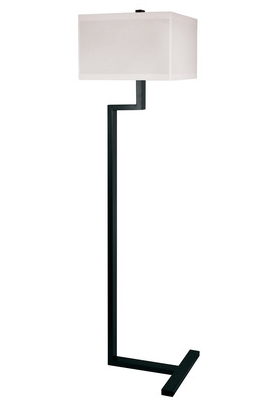 Right Angle Metal Floor Lamp in Bronze , 902 by Lamp Works[/caption]
Floor lamps are great because they're typically easy to move, can be set up anywhere with an outlet, and don't need a table or desk to be set up. They're another good option when you have limited work space, and would also make a cool alternative to an overhead light. Lamp Works has a variety of styles, from very traditional upright lamps, to this more whimsical right-angle lamp. I think this would look great with a dark leather couch or any kind of monochromatic theme.
Well Ensconced
[caption id="attachment_13814" align="aligncenter" width="334"]
Right Angle Metal Floor Lamp in Bronze , 902 by Lamp Works[/caption]
Floor lamps are great because they're typically easy to move, can be set up anywhere with an outlet, and don't need a table or desk to be set up. They're another good option when you have limited work space, and would also make a cool alternative to an overhead light. Lamp Works has a variety of styles, from very traditional upright lamps, to this more whimsical right-angle lamp. I think this would look great with a dark leather couch or any kind of monochromatic theme.
Well Ensconced
[caption id="attachment_13814" align="aligncenter" width="334"]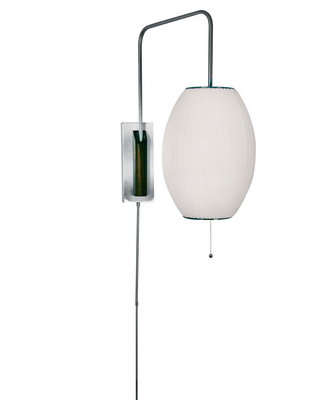 Cigar Swingarm Wall Sconce in White, 402 by Lamp Works[/caption]
This is another cool option for getting your lights off your table and freeing up space. It would take a little more effort for installation, but after that a sconce would be a great addition--it could in theory be easily incorporated into a modern or old-fashioned decor. Again, these are offered in both incandescent and LED.
Lamps may not rank high on your list of most coveted items for the new year, but they're worth putting some thought into. Chances are good you can find or two to match your decor, and the selections from Lamp Works are a great place to start....
Cigar Swingarm Wall Sconce in White, 402 by Lamp Works[/caption]
This is another cool option for getting your lights off your table and freeing up space. It would take a little more effort for installation, but after that a sconce would be a great addition--it could in theory be easily incorporated into a modern or old-fashioned decor. Again, these are offered in both incandescent and LED.
Lamps may not rank high on your list of most coveted items for the new year, but they're worth putting some thought into. Chances are good you can find or two to match your decor, and the selections from Lamp Works are a great place to start....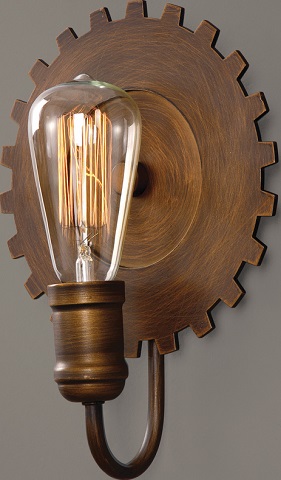 Antrim Bronze Sconce 22600 from Uttermost[/caption]
The intricate coils of filament inside antique bulbs are what make them so visually arresting, but also what makes them inefficient. Contemporary incandescent bulbs have a single, short strip of filament that produces a bright yellow-white light, too bright to look at directly. But antique bulbs use filament made of different materials, like tungsten, that produce a dimmer amber-orange light, and require a lot more filament to produce the same amount of light. The result is complex twists of glowing filament inside the bulb that are just dim enough to look at comfortably, but that burn out quickly, draw a lot of power, and produce a lot of heat.
[caption id="attachment_13876" align="aligncenter" width="480"]
Antrim Bronze Sconce 22600 from Uttermost[/caption]
The intricate coils of filament inside antique bulbs are what make them so visually arresting, but also what makes them inefficient. Contemporary incandescent bulbs have a single, short strip of filament that produces a bright yellow-white light, too bright to look at directly. But antique bulbs use filament made of different materials, like tungsten, that produce a dimmer amber-orange light, and require a lot more filament to produce the same amount of light. The result is complex twists of glowing filament inside the bulb that are just dim enough to look at comfortably, but that burn out quickly, draw a lot of power, and produce a lot of heat.
[caption id="attachment_13876" align="aligncenter" width="480"]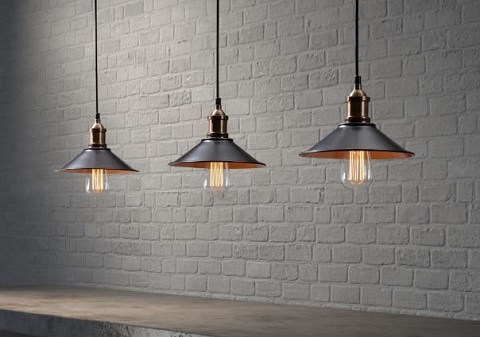 Amarillite Ceiling Lamp 98257 from Zuo Modern[/caption]
LED filament bulbs skirt this problem in an ingenious way: by taking the filament out of the bulb entirely and replacing it with small LED lights. That's right, LED filament bulbs are essentially antique glass bulbs with several tiny, orange colored light bulbs inside them. The main benefit of this is that LED lights are among the most efficient forms of lighting, using very little energy and giving off minimal heat. They can also be made in very, very small shapes and easily customized to change color, which makes them an ideal substitute for actual filament.
[caption id="attachment_13877" align="aligncenter" width="241"]
Amarillite Ceiling Lamp 98257 from Zuo Modern[/caption]
LED filament bulbs skirt this problem in an ingenious way: by taking the filament out of the bulb entirely and replacing it with small LED lights. That's right, LED filament bulbs are essentially antique glass bulbs with several tiny, orange colored light bulbs inside them. The main benefit of this is that LED lights are among the most efficient forms of lighting, using very little energy and giving off minimal heat. They can also be made in very, very small shapes and easily customized to change color, which makes them an ideal substitute for actual filament.
[caption id="attachment_13877" align="aligncenter" width="241"] Jonas Table Lamp 14284-1 from ELK Lighting[/caption]
Like conventional antique bulbs, LED filament bulbs produce a mellow amber light, and in most cases can be used interchangeably in the same sockets (though be sure to double check before you buy!). LED filament bulbs are also usually dimmable, too, but unlike true filament bulbs that change color as they're dimmed (going from bright gold to a hot orange-red at their lowest settings), LED filament bulbs produce less light as they're dimmed, but stay the same color. At their brightest setting, LED filament bulbs also produce a slightly brighter light than their antique counterparts.
[caption id="attachment_13874" align="aligncenter" width="454"]
Jonas Table Lamp 14284-1 from ELK Lighting[/caption]
Like conventional antique bulbs, LED filament bulbs produce a mellow amber light, and in most cases can be used interchangeably in the same sockets (though be sure to double check before you buy!). LED filament bulbs are also usually dimmable, too, but unlike true filament bulbs that change color as they're dimmed (going from bright gold to a hot orange-red at their lowest settings), LED filament bulbs produce less light as they're dimmed, but stay the same color. At their brightest setting, LED filament bulbs also produce a slightly brighter light than their antique counterparts.
[caption id="attachment_13874" align="aligncenter" width="454"] LED vs Vintage Filament Bulbs from ELK Lighting[/caption]
It's worth noting that LED lights, however small, aren't a perfect match for traditional tungsten filament. For one, the tiny bulbs are thicker than the thread-thin lines of filament, and not nearly as flexible. While the filament in an antique incandescent bulb is coiled and wound in intricate, curvy patterns, LED filament bulbs are necessarily a bit more angular, with crisscrossing straight lines that offer a similar visual complexity, but one that's discernibly different on a close inspection, with solid blocks of light rather than thin, overlapping lines.
[caption id="attachment_13878" align="aligncenter" width="388"]
LED vs Vintage Filament Bulbs from ELK Lighting[/caption]
It's worth noting that LED lights, however small, aren't a perfect match for traditional tungsten filament. For one, the tiny bulbs are thicker than the thread-thin lines of filament, and not nearly as flexible. While the filament in an antique incandescent bulb is coiled and wound in intricate, curvy patterns, LED filament bulbs are necessarily a bit more angular, with crisscrossing straight lines that offer a similar visual complexity, but one that's discernibly different on a close inspection, with solid blocks of light rather than thin, overlapping lines.
[caption id="attachment_13878" align="aligncenter" width="388"]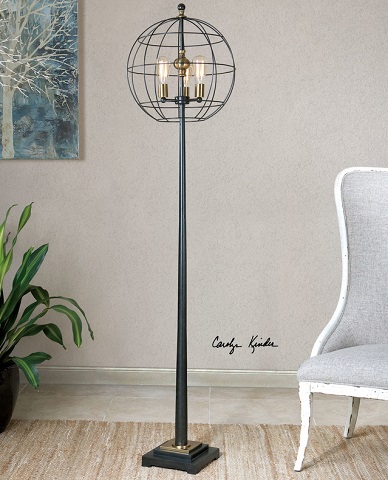 Palla Round Cage Floor Lamp 28628-1 from Uttermost[/caption]
That said, what LED filament bulbs lack in authenticity, they make up for in flexibility. Because the internal conditions of the bulb don't matter (which they very much do for antique filament), these faux antique bulbs can come in almost any size or shape, from standard bulbs to any array of whimsical blown glass casings. And at a distance, the LEDs inside can easily pass for the real deal, whether the surrounding bulb is left completely exposed or installed in a larger fixture.
[caption id="attachment_13879" align="aligncenter" width="480"]
Palla Round Cage Floor Lamp 28628-1 from Uttermost[/caption]
That said, what LED filament bulbs lack in authenticity, they make up for in flexibility. Because the internal conditions of the bulb don't matter (which they very much do for antique filament), these faux antique bulbs can come in almost any size or shape, from standard bulbs to any array of whimsical blown glass casings. And at a distance, the LEDs inside can easily pass for the real deal, whether the surrounding bulb is left completely exposed or installed in a larger fixture.
[caption id="attachment_13879" align="aligncenter" width="480"] Roll Table Lamp 50306 from Zuo Modern[/caption]
All kinds of antique bulbs are slightly more expensive than standard ones (LED or otherwise) because they require a certain degree of craftsmanship to create, and LED filament bulbs are slightly more expensive than conventional filament bulbs, in part because they have small, built-in circuit boards that filament bulbs don't. As with all LED lights, though, LED filament bulbs are made to have a very, very long lifespan. Incandescent bulbs - especially vintage bulbs - tend to burn out fairly quickly, but LEDs are much less delicate and can keep putting out light for years. So while they might cost a bit more up front, not only will they cost less to use because they're more efficient, but you also won't need to replace them as often.
Getting a stylish, vintage look doesn't have to mean hauling out actual antiques; a little technology can make it possible to get gorgeous industrial style lighting without setting your home back a hundred years....
Roll Table Lamp 50306 from Zuo Modern[/caption]
All kinds of antique bulbs are slightly more expensive than standard ones (LED or otherwise) because they require a certain degree of craftsmanship to create, and LED filament bulbs are slightly more expensive than conventional filament bulbs, in part because they have small, built-in circuit boards that filament bulbs don't. As with all LED lights, though, LED filament bulbs are made to have a very, very long lifespan. Incandescent bulbs - especially vintage bulbs - tend to burn out fairly quickly, but LEDs are much less delicate and can keep putting out light for years. So while they might cost a bit more up front, not only will they cost less to use because they're more efficient, but you also won't need to replace them as often.
Getting a stylish, vintage look doesn't have to mean hauling out actual antiques; a little technology can make it possible to get gorgeous industrial style lighting without setting your home back a hundred years....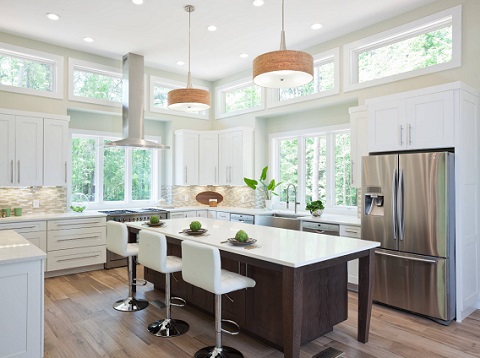 Replacing a single bright lighting fixture with lots of smaller ones spaced evenly throughout the room will give you better over-all illumination and help combat the shadowy corners of your kitchen (by Turan Designs)[/caption]
The bare minimum lighting for a kitchen is one bright light stuck right smack dab in the middle of the ceiling, meant to cast light over the whole kitchen at once. The problem with this setup is that the light you get is never quite where you need it. In order to get all-over coverage, the light is located as far away from your actual workspace as possible, and in order to be bright enough to reach the far walls, the light these fixtures produce is often excessively harsh and bright. Replacing a single flush-mount fixture with several can style recessed lights is a good first step. They produce a more moderate, even light, can be positioned strategically near your work surfaces, and illuminate your kitchen from all angles, rather than just from a fixed point in the middle. Bonus: if you put them on a dimmer switch, they can double as mood lighting when you don't need bright lights to see by.
Replacing a single bright lighting fixture with lots of smaller ones spaced evenly throughout the room will give you better over-all illumination and help combat the shadowy corners of your kitchen (by Turan Designs)[/caption]
The bare minimum lighting for a kitchen is one bright light stuck right smack dab in the middle of the ceiling, meant to cast light over the whole kitchen at once. The problem with this setup is that the light you get is never quite where you need it. In order to get all-over coverage, the light is located as far away from your actual workspace as possible, and in order to be bright enough to reach the far walls, the light these fixtures produce is often excessively harsh and bright. Replacing a single flush-mount fixture with several can style recessed lights is a good first step. They produce a more moderate, even light, can be positioned strategically near your work surfaces, and illuminate your kitchen from all angles, rather than just from a fixed point in the middle. Bonus: if you put them on a dimmer switch, they can double as mood lighting when you don't need bright lights to see by.
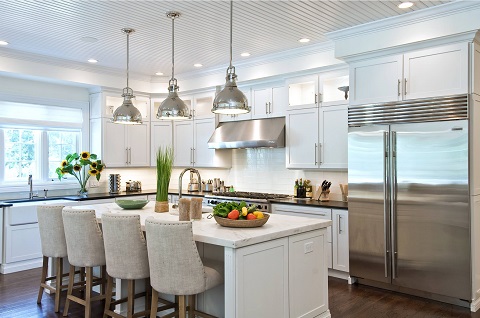 Centering your kitchen's primary task lighting around the perimeter of the room rather than in the center of it is an easy way to improve your task lighting (by EB Designs)[/caption]
If you do a lot of cooking, it can also be worthwhile to actually install separate lights directly over your workspace, either mounted to the ceiling above the cabinets or mounted to the underside of the cabinets above your counter. These lights are purely functional, chasing back the shadows and making it easier to see while you're working, but they can be particularly worthwhile if you have deep cabinets or a kitchen that doesn't get much natural light. That said, good task lighting should illuminate key areas of your kitchen, like a spotlight. The lights built into range hoods are a good example: they make it easier to see while you're cooking, but a good one will also add a warm glow to the area around your range.
Centering your kitchen's primary task lighting around the perimeter of the room rather than in the center of it is an easy way to improve your task lighting (by EB Designs)[/caption]
If you do a lot of cooking, it can also be worthwhile to actually install separate lights directly over your workspace, either mounted to the ceiling above the cabinets or mounted to the underside of the cabinets above your counter. These lights are purely functional, chasing back the shadows and making it easier to see while you're working, but they can be particularly worthwhile if you have deep cabinets or a kitchen that doesn't get much natural light. That said, good task lighting should illuminate key areas of your kitchen, like a spotlight. The lights built into range hoods are a good example: they make it easier to see while you're cooking, but a good one will also add a warm glow to the area around your range.
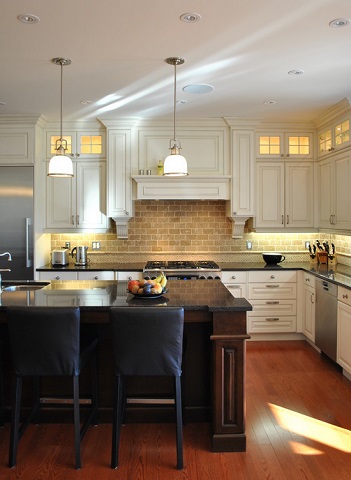 Under cabinet lights aren't just functional, they also do a great job bringing out the detail in your backsplash and adding depth to your countertops (by 2Go Custom Kitchens)[/caption]
Under cabinet lights offer a nice combination of style and function. They can be used, as I mentioned above, for brightening up your counters and making it easier to work. But spaced throughout your entire kitchen, they can also be used to draw attention to the small strip of wall between the bottom of the cabinets and the countertop. This works best if you have textured walls or a decorative tile backsplash; a few small cabinet lights mounted beneath your cabinets not only chase back the shadows, but will make your kitchen seem to glow, highlighting the color and texture of the wall.
Under cabinet lights aren't just functional, they also do a great job bringing out the detail in your backsplash and adding depth to your countertops (by 2Go Custom Kitchens)[/caption]
Under cabinet lights offer a nice combination of style and function. They can be used, as I mentioned above, for brightening up your counters and making it easier to work. But spaced throughout your entire kitchen, they can also be used to draw attention to the small strip of wall between the bottom of the cabinets and the countertop. This works best if you have textured walls or a decorative tile backsplash; a few small cabinet lights mounted beneath your cabinets not only chase back the shadows, but will make your kitchen seem to glow, highlighting the color and texture of the wall.
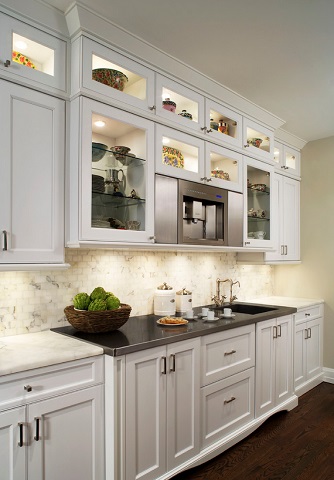 Small spotlights - whether they're aimed at your dishes or the architectural features of your kitchen - can bring out the subtly stylish details of your space (by Millennium Cabinetry, photo by Beth Singer)[/caption]
The same goes for in-cabinet and above-cabinet lighting. In this case, they aren't remotely necessary or functional, but they can add depth and character to your kitchen. Open or glass-fronted cabinets that are illuminated from the inside are incredibly eye-catching. Like spotlit museum displays, they draw the eye and turn your everyday dinnerware and dishes into something that stands out and feels worth looking at. Alternately, small lights placed on top of your cabinets are great for accentuating the height of your kitchen, especially if you have gabled ceilings or exposed beams. Both types of light draw attention to areas typically lost to shadows, and give your kitchen a soft, warm, inviting glow.
Small spotlights - whether they're aimed at your dishes or the architectural features of your kitchen - can bring out the subtly stylish details of your space (by Millennium Cabinetry, photo by Beth Singer)[/caption]
The same goes for in-cabinet and above-cabinet lighting. In this case, they aren't remotely necessary or functional, but they can add depth and character to your kitchen. Open or glass-fronted cabinets that are illuminated from the inside are incredibly eye-catching. Like spotlit museum displays, they draw the eye and turn your everyday dinnerware and dishes into something that stands out and feels worth looking at. Alternately, small lights placed on top of your cabinets are great for accentuating the height of your kitchen, especially if you have gabled ceilings or exposed beams. Both types of light draw attention to areas typically lost to shadows, and give your kitchen a soft, warm, inviting glow.
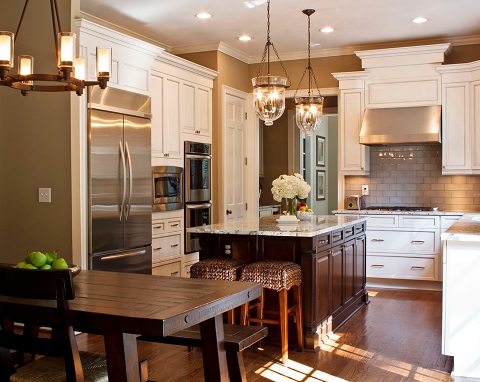 Big, eye-grabbing lighting fixtures placed directly over a table or island can help differentiate between the different zones of a greatroom (by Great Spaces!, photo by Reed Lewis)[/caption]
In a large kitchen, or one with an open floor plan that connects to a larger greatroom, layering different types of lighting fixtures can also help give your space definition. Good over-all lighting will ensure that no part of your kitchen is dark, but hanging a large, decorative lighting fixture directly over a kitchen table, dining table, or kitchen island will help set it off from the rest of the space, even if there aren't any physical barriers between the different "zones" of the room. In the same way a good area rug can tie together a living room set, a hefty light can make a few pieces of furniture left adrift in a large space really feel like they belong there.
Big, eye-grabbing lighting fixtures placed directly over a table or island can help differentiate between the different zones of a greatroom (by Great Spaces!, photo by Reed Lewis)[/caption]
In a large kitchen, or one with an open floor plan that connects to a larger greatroom, layering different types of lighting fixtures can also help give your space definition. Good over-all lighting will ensure that no part of your kitchen is dark, but hanging a large, decorative lighting fixture directly over a kitchen table, dining table, or kitchen island will help set it off from the rest of the space, even if there aren't any physical barriers between the different "zones" of the room. In the same way a good area rug can tie together a living room set, a hefty light can make a few pieces of furniture left adrift in a large space really feel like they belong there.
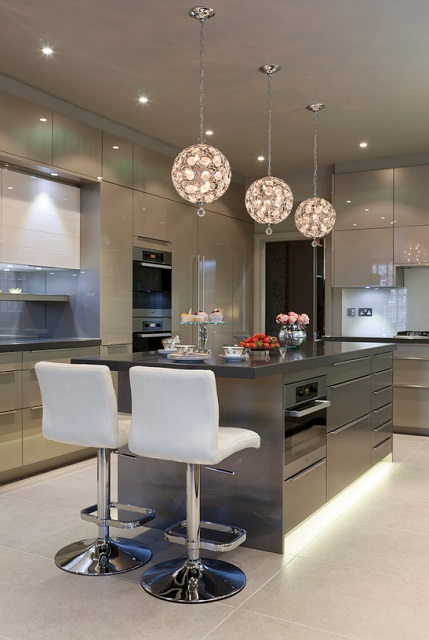 When your task lighting blends into the background, a few decorative lights can really steal the show (by Neil Lerner)[/caption]
Good layered lighting is mostly about the lights you don't see: recessed lights, hidden spotlights, tiny accent lights, and so on that give you full lighting coverage and fill the gaps left by larger single fixtures. But the flip side of that is that if you don't need to rely on a single fixture for functionality, you have a lot more freedom to get creative with its style. A prominently placed chandelier, a large island light, or even a series of decorative pendants can be a major design feature of your kitchen.
When the hidden fixtures take care of the actual lighting part, a big, bold fixture can really stand out and shine, giving you the best of both worlds....
When your task lighting blends into the background, a few decorative lights can really steal the show (by Neil Lerner)[/caption]
Good layered lighting is mostly about the lights you don't see: recessed lights, hidden spotlights, tiny accent lights, and so on that give you full lighting coverage and fill the gaps left by larger single fixtures. But the flip side of that is that if you don't need to rely on a single fixture for functionality, you have a lot more freedom to get creative with its style. A prominently placed chandelier, a large island light, or even a series of decorative pendants can be a major design feature of your kitchen.
When the hidden fixtures take care of the actual lighting part, a big, bold fixture can really stand out and shine, giving you the best of both worlds....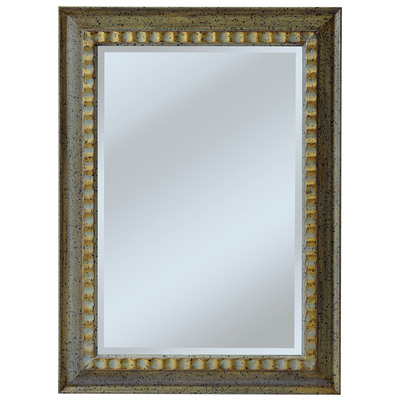 Parnell Mirror, MW4049-0022 by Mirror Works[/caption]
Putting aside decorating choices for a moment, I really recommend investing in a simple but high-quality mirror. Cheaper mirrors can easily become warped, and the ones that come built into houses (in bathrooms, for instance) are often not anywhere with decent light. I spent a semester in college fighting three other people for a narrow strip of glass with almost funhouse proportions, hung in a bathroom with lighting that made me look like a horror movie extra. Never again. A nice mirror is definitely worth the money and wall space.
Shop Mirrors by Mirror Masters:
Reflective Expression
[caption id="attachment_13936" align="aligncenter" width="400"]
Parnell Mirror, MW4049-0022 by Mirror Works[/caption]
Putting aside decorating choices for a moment, I really recommend investing in a simple but high-quality mirror. Cheaper mirrors can easily become warped, and the ones that come built into houses (in bathrooms, for instance) are often not anywhere with decent light. I spent a semester in college fighting three other people for a narrow strip of glass with almost funhouse proportions, hung in a bathroom with lighting that made me look like a horror movie extra. Never again. A nice mirror is definitely worth the money and wall space.
Shop Mirrors by Mirror Masters:
Reflective Expression
[caption id="attachment_13936" align="aligncenter" width="400"] Chartwell Mirror, MP4063-0020 by Mirror Masters[/caption]
Of course, once you know you've got a decent place to check your hair, you can start thinking about the other applications of mirrors--such as their value as art. There are a vast number of home accents that double as mirrors, or at least incorporate some kind of reflective surface. Like this starburst up above, they can become quite ornate. You wouldn't want too many of these, but as the centerpiece to a living room or front entrance, it would work great. Whether your taste is baroque or utilitarian, you'll be able to find something that works.
Shop Mirrors:
Patterns in Light
[caption id="attachment_13935" align="aligncenter" width="468"]
Chartwell Mirror, MP4063-0020 by Mirror Masters[/caption]
Of course, once you know you've got a decent place to check your hair, you can start thinking about the other applications of mirrors--such as their value as art. There are a vast number of home accents that double as mirrors, or at least incorporate some kind of reflective surface. Like this starburst up above, they can become quite ornate. You wouldn't want too many of these, but as the centerpiece to a living room or front entrance, it would work great. Whether your taste is baroque or utilitarian, you'll be able to find something that works.
Shop Mirrors:
Patterns in Light
[caption id="attachment_13935" align="aligncenter" width="468"]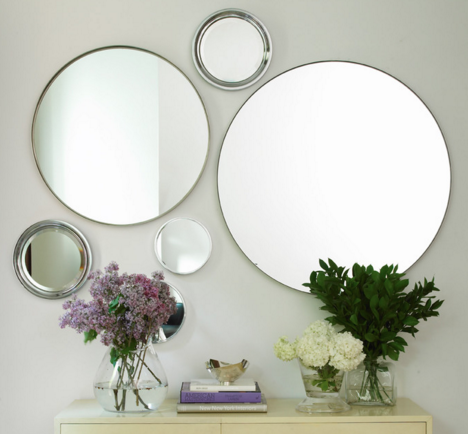 Multiple mirrors achieve a unique effect. (By Jarlath Mallet. Photograph by Tria Giovan.)[/caption]
Keep in mind that you don't need fancy art pieces in order to do something cool with mirrors! A few small mirrors, or several of different sizes, can be used to very stylish effect just about anywhere. It's a very do-it-yourself approach to decor, for somewhere you don't want one huge piece to dominate. My favorite go-to place for this is on a staircases or in a hallway, so guests catch just tiny glimpses of themselves as they move through the house.
Shop Mirrors:
Objects are Closer than they Appear
[caption id="attachment_13937" align="aligncenter" width="505"]
Multiple mirrors achieve a unique effect. (By Jarlath Mallet. Photograph by Tria Giovan.)[/caption]
Keep in mind that you don't need fancy art pieces in order to do something cool with mirrors! A few small mirrors, or several of different sizes, can be used to very stylish effect just about anywhere. It's a very do-it-yourself approach to decor, for somewhere you don't want one huge piece to dominate. My favorite go-to place for this is on a staircases or in a hallway, so guests catch just tiny glimpses of themselves as they move through the house.
Shop Mirrors:
Objects are Closer than they Appear
[caption id="attachment_13937" align="aligncenter" width="505"]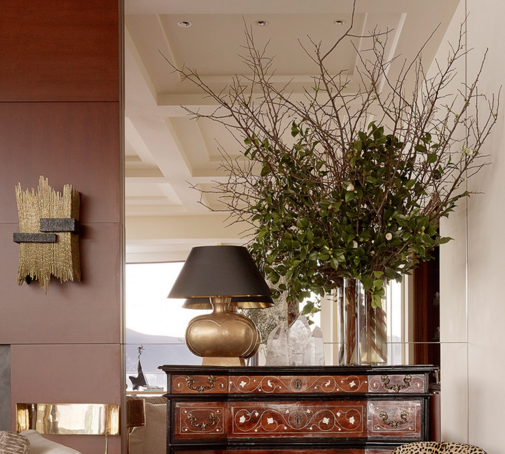 Objects in front of mirrors is a tried and true illusion. (By Tucker and Marks)[/caption]
Beyond being great accents in and of themselves, mirrors are by their very nature a huge weapon in your interior design arsenal--they open up space. A well-placed mirror can make a room seem twice as big, enlivening cramped spaces and brightening up dark ones. Just make sure you're strategic about where you place them--your guests probably don't want to spend their whole evening staring at a reflection of themselves from the couch.
Shop Mirrors:
A Trick of the Light
[caption id="attachment_13938" align="aligncenter" width="498"]
Objects in front of mirrors is a tried and true illusion. (By Tucker and Marks)[/caption]
Beyond being great accents in and of themselves, mirrors are by their very nature a huge weapon in your interior design arsenal--they open up space. A well-placed mirror can make a room seem twice as big, enlivening cramped spaces and brightening up dark ones. Just make sure you're strategic about where you place them--your guests probably don't want to spend their whole evening staring at a reflection of themselves from the couch.
Shop Mirrors:
A Trick of the Light
[caption id="attachment_13938" align="aligncenter" width="498"] Use mirrors to create an otherworldly space. (By Alysson Ross Markley)[/caption]
There is really no limit to how you can incorporate mirrors into your decor. Like a nineteenth century stage magician, you can use them for all sorts of visual tricks. Up above is one of my favorites--a looking glass in the garden opening up a hidden, slightly eerie space. This would be especially great for a small, enclose garden. Strategically placed mirrors can also widen halls and make objects float; a sink with a mirrored base will look like it's defying gravity.
Mirrors are a great investment, hands down. They're easy to find, easy to hang, and require very little maintenance beyond a little windex now and again. Instead of cluttering up a room they open it, and the number of tricks they can perform is only limited to your imagination.
Shop Mirrors: ...
Use mirrors to create an otherworldly space. (By Alysson Ross Markley)[/caption]
There is really no limit to how you can incorporate mirrors into your decor. Like a nineteenth century stage magician, you can use them for all sorts of visual tricks. Up above is one of my favorites--a looking glass in the garden opening up a hidden, slightly eerie space. This would be especially great for a small, enclose garden. Strategically placed mirrors can also widen halls and make objects float; a sink with a mirrored base will look like it's defying gravity.
Mirrors are a great investment, hands down. They're easy to find, easy to hang, and require very little maintenance beyond a little windex now and again. Instead of cluttering up a room they open it, and the number of tricks they can perform is only limited to your imagination.
Shop Mirrors: ...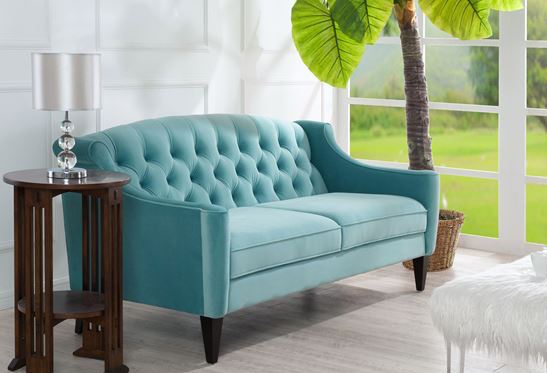 Ken Velvet Sofa, 63001-3-894 by Jennifer Taylor[/caption]
Shop Sofas and Loveseat by Jennifer Taylor:
Although you may not be feeling particularly beachy at this point in the year, this is honestly the best time to bring in a little light and airiness, as we progress into the darker, drearier months. A beach or cottage aesthetic (and I am grouping them together because they rely on a lot of the same design elements) hinge on pastel colors, light, unfinished wood, and patterned fabrics. For a beach theme, think more nautical patterns, stripes and pastels, and think florals for cottages. With the pal that tends to hang over the mood in this season, calm, bright aesthetics may do you more good than you expect.
[caption id="attachment_14248" align="aligncenter" width="500"]
Ken Velvet Sofa, 63001-3-894 by Jennifer Taylor[/caption]
Shop Sofas and Loveseat by Jennifer Taylor:
Although you may not be feeling particularly beachy at this point in the year, this is honestly the best time to bring in a little light and airiness, as we progress into the darker, drearier months. A beach or cottage aesthetic (and I am grouping them together because they rely on a lot of the same design elements) hinge on pastel colors, light, unfinished wood, and patterned fabrics. For a beach theme, think more nautical patterns, stripes and pastels, and think florals for cottages. With the pal that tends to hang over the mood in this season, calm, bright aesthetics may do you more good than you expect.
[caption id="attachment_14248" align="aligncenter" width="500"]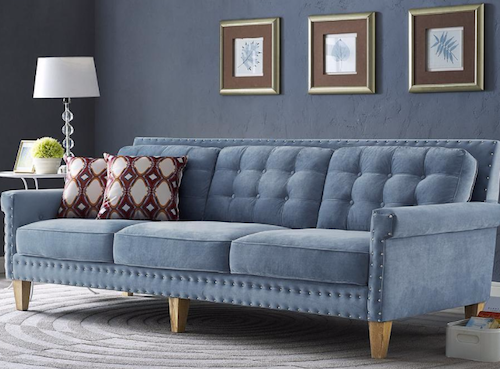 Jonathan Blue Velvet Sofa , TOV-S75 by TOV[/caption]
Shop Sofas and Loveseat by TOV Furniture:
Speaking of impact on mood, colors are one of the most reliable ways to alter the vibe of a room, as they are really the first thing anyone notices, whether consciously or not. There have been actual studies on the subliminal messages we get from different colors. Often they are used in marketing or businesses--for instance, deeper colors like red and orange are said to stimulate appetite so often restaurants will use them. Blue is often closely associated with the mind and serenity, imparting a sense of calm and stillness. We also connect the ocean and the woods with placidity and contemplation, so adopting a style that pulls from that can really chill down your vibe.
[caption id="attachment_14254" align="aligncenter" width="400"]
Jonathan Blue Velvet Sofa , TOV-S75 by TOV[/caption]
Shop Sofas and Loveseat by TOV Furniture:
Speaking of impact on mood, colors are one of the most reliable ways to alter the vibe of a room, as they are really the first thing anyone notices, whether consciously or not. There have been actual studies on the subliminal messages we get from different colors. Often they are used in marketing or businesses--for instance, deeper colors like red and orange are said to stimulate appetite so often restaurants will use them. Blue is often closely associated with the mind and serenity, imparting a sense of calm and stillness. We also connect the ocean and the woods with placidity and contemplation, so adopting a style that pulls from that can really chill down your vibe.
[caption id="attachment_14254" align="aligncenter" width="400"]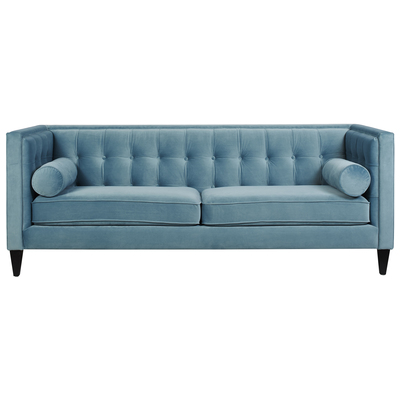 Jack Arctic Blue Velvet Sofa, 8403-3-894 by Jennifer Taylor[/caption]
Blue, turquoise, and teal are all great colors for waking up a room--they immediately draw the eye, but aren't noisy in the same way that red, pink, and orange can be. Another more practical upside to decorating with blue and turquoise furniture is the fact that they don't show stains very easily. My dad had a grey-blue couch that we had for years that seemed to magically swallow anything that got spilled on it. Of course, the downside is that you will have a grimy couch and not be aware of it, but a regular cleaning can easily get around that problem.
[caption id="attachment_14253" align="aligncenter" width="400"]
Jack Arctic Blue Velvet Sofa, 8403-3-894 by Jennifer Taylor[/caption]
Blue, turquoise, and teal are all great colors for waking up a room--they immediately draw the eye, but aren't noisy in the same way that red, pink, and orange can be. Another more practical upside to decorating with blue and turquoise furniture is the fact that they don't show stains very easily. My dad had a grey-blue couch that we had for years that seemed to magically swallow anything that got spilled on it. Of course, the downside is that you will have a grimy couch and not be aware of it, but a regular cleaning can easily get around that problem.
[caption id="attachment_14253" align="aligncenter" width="400"]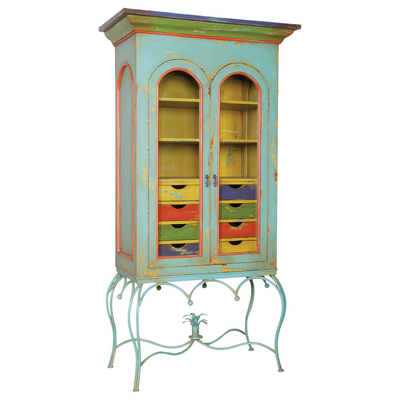 Caravan Display Cabinet, 602003 by Guild Master[/caption]
Shop Chest and Cabinets by Guild Master:
Weathered wood and shabby chic aesthetics are key parts of the beach and cottage styles. Think looks that suggest your furniture has been laid into by the elements--the sea air or the slowly encroaching forces of nature. Of course, there’s a fine line between shabby and junky, but this style is great way to push those boundaries. Guild Master in particular has a lot of great styles of weathered and vintage furniture.
Building a room or home around a color rather than a particular style may seem counterintuitive at first, but it actually makes a lot of sense. You don't have to be rigid in your choice of materials, accents, or time periods, you just have to make sure it balances with the colors. And since blues are very common this season, it's easy to find the perfect piece, whether it's to blend in seamlessly or make a statement.
...
Caravan Display Cabinet, 602003 by Guild Master[/caption]
Shop Chest and Cabinets by Guild Master:
Weathered wood and shabby chic aesthetics are key parts of the beach and cottage styles. Think looks that suggest your furniture has been laid into by the elements--the sea air or the slowly encroaching forces of nature. Of course, there’s a fine line between shabby and junky, but this style is great way to push those boundaries. Guild Master in particular has a lot of great styles of weathered and vintage furniture.
Building a room or home around a color rather than a particular style may seem counterintuitive at first, but it actually makes a lot of sense. You don't have to be rigid in your choice of materials, accents, or time periods, you just have to make sure it balances with the colors. And since blues are very common this season, it's easy to find the perfect piece, whether it's to blend in seamlessly or make a statement.
...